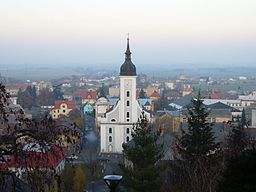Javorník (Jeseník District)
| Javorník | |||
| Javorník u Jeseníku, Javorník ve Slezsku | |||
| Town | |||
|
Holy Trinity church as seen from the castle
|
|||
|
|||
| Name origin: maple forest/hill/stream | |||
| Country | |||
|---|---|---|---|
| Region | Olomouc | ||
| District | Jeseník | ||
| Commune | Jeseník | ||
| Municipality | Javorník | ||
| Elevation | 295 m (968 ft) | ||
| Coordinates | 50°23′39″N 017°00′22″E / 50.39417°N 17.00611°ECoordinates: 50°23′39″N 017°00′22″E / 50.39417°N 17.00611°E | ||
| Area | 77.43 km2 (29.90 sq mi) | ||
| Population | 3,014 (2006-10-02) | ||
| Density | 39/km2 (101/sq mi) | ||
| Founded | 14th century | ||
| Mayor | Jiří Štrajt | ||
| Timezone | CET (UTC+1) | ||
| - summer (DST) | CEST (UTC+2) | ||
| Postal code | 790 70 | ||
| Statistics: statnisprava.cz | |||
| Website: www.mestojavornik.cz | |||
Javorník (Czech pronunciation: [ˈjavorɲiːk]) or Javorník u Jeseníku or Javorník ve Slezsku, (German: Jauernig), is a town in the Jeseník District of the Olomouc Region, Javorník Hook, Czech Republic. From 1938 to 1945 it was one of the municipalities in Sudetenland. It has about 2,900 inhabitants.
The town, which lies in the foothills of Rychlebské Hory (German: Reichensteiner Gebirges), was established under a medieval fortress, what would later become castle Johannesberg, at the beginning of the 14th century. It belonged to the principality of Neisse-Grottkau, which was under the rule of the prince-bishops of Breslau.
From 1428 until 1432, during the Hussite Wars, Javorník and its fort were under siege by the Hussites. They left the village and the fortress in ruins, and it was not until the early 16th century when Jan Thurzo, Prince-Bishop of Breslau, built the castle Johannesberg on the remains of the old stronghold of Jauernig. During his reign Javorník gained importance as a mining settlement as several silver and iron ore mines were established in the area. In 1549 the village finally became a town and a first school was also established. Unfortunately, in 1576 the town’s growth was hampered as it was ravaged by a fire. The devastation was minor however, compare to the destruction Javorník experienced during the Thirty Years War, especially then in 1646. The settlement was nearly completely destroyed and it was not until eight years later that Javorník became once again a prosperous town, now with a church, school, town hall and a brewery.
...
Wikipedia





